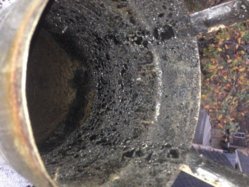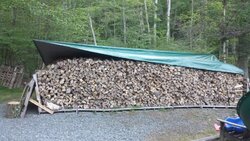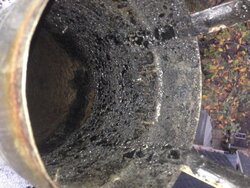Hello everyone,
I need your thoughts on my experience and some ideas on reducing creosote formation. My F55 is installed in my basement. The brick chimney runs outside the house and I have it lined with a 6" flexible liner that is connected to my stove. Total chimney height basement to cap is about 25'. After burning approx 3 cords of wood through my stove last year (first season with this stove), I inspected my chimney and found that there was some hard/glaze creosote at the top end of my chimney. I bought the Gardus Sooteater and this weekend I gave it its first use, cleaning from the bottom up. The Sooteater worked pretty good, but I wasn't able to to remove 100% of the glaze from the top end of the chimney. This is what the top end of my pipe looked like AFTER it was cleaned:

My apologies for the sideways picture, but you get the idea. Obviously, there is still a little bit of glaze left, although I would say its about 90% better. I ran the Sooteater over this area multiple times. The good news is that the bottom end of the pipe only had a moderate amount of brown/black fluffy stuff that was easily removed, so that end of the pipe isn't a major concern. My wood last year was pretty good overall - most under 20% moisture on the MM. I may have been a bit aggressive in choking the air off on the stove in order to get a longer overnight burn. Typically, I would get it down to about 1/4 to 1/3 open and then leave it there for the night. The stove has always drafted well and combustion air comes from an outside air kit. My main goal it to burn cleaner this winter and avoid the nasty glaze creosote, so I'll throw it out to my fellow F55 owners to see if anyone can share their experiences on burning clean and keeping their pipe glaze free ...
... I am considering installing a block off plate above my stove, and my wood this winter will be very well seasoned as I have stocked up on some 3+ years seasoned larch, fir and maple. I know my chimney setup isn't ideal being completely outside the envelope of the house, but its in good shape and won't be rebuilt anytime soon.









